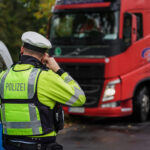Will TRACE 2 Guidance be Considered by Foreign Authorities to harmonize Roadside Checks’ practices?
Since the implementation of Mobility Package 1, navigating international transportation rules has become quite challenging. Each country often interprets regulations differently, and discrepancies may arise not only between regions but also among various controlling authorities within the same country. Moreover, each Member State has its own set of penalties and control practices on. These variations become evident when comparing them to the ERRU register reference.
Therefore, on December 20th, 2023, the TRACE 2 project was initiated to streamline the implementation of rules introduced by Mobility Package 1, focusing on efficiency and harmonization. It was implemented under the leadership of CORTE in collaboration with partners like IRU, ETF, and SQUARIS Consultants, along with involvement from ROADPOL and ECR, to address changes brought about by Mobility Package 1. The project developed enforcement guidance, training materials, and organized training sessions for enforcers across the European Union.
What drives TRACE 2 Guidance?
The Purpose Behind TRACE 2 builds on the success of the TRACE project, known for its role in harmonizing EU rules on driving and rest time enforcement before Mobility Package 1.
The accurate application and adherence to these rules play a pivotal role in realizing the objectives of road transport legislation, including improving working conditions for drivers, ensuring fair competition among operators, and enhancing overall road safety.
The work under TRACE 2 related to different topics impacted by Mobility Package 1 resulted in enforcement guidance documents and other materials that can be useful to train enforcers across Europe and harmonize enforcement practices.
In this context, this generated guidance covering various topics affected by Mobility Package 1 should be poised to actively foster the dissemination of best practices for roadside checks across Europe.
In theory, the primary goal should be to establish a cohesive, common, and shared understanding of the existing posting rules, ensuring their consistent and effective enforcement across the European Union—a goal that, unfortunately, diverges from the reality we currently face during roadside checks…
What areas does TRACE 2 address?
The TRACE 2 document delves into five key aspects: driving and resting time, tachograph usage, posting of drivers, access to the profession, and access to the market.
This document is a valuable guide for the application and enforcement of modified and new rules related to 5 key documents / areas:
- posting of drivers,
- driving and resting time,
- access to market /cabotage operations,
- access to profession/ stable establishment requirements,
- and the proper utilization of tools like the tachograph.
The TRACE 2 document serves as an updated and complementary resource to the existing Trace explanatory text. It reflects the legislative changes brought about by Mobility Package 1, adopted in July 2020. This document is a valuable guide for the application and enforcement of modified and new rules related to driving and rest times, posting of drivers, cabotage operations, stable establishment requirements, and the proper utilization of tools like the tachograph.
Comprehensive Overview of Key Documents
In the introductory section dedicated to posting of drivers, the document highlights that « successful enforcement will depend very much on a shared and thorough understanding of the applicable rules and on efficient cooperation between all competent authorities within each Member States as well all Member States. »
Among other things, in the document on the posting of drivers, we can find information on when drivers are considered or not posted during operations. We discussed this already via our specialist’s articles on our blog:
- Posting Scenarios Explained: Cross-trade Operations – Truck Mobility Info – 2024 (truckmobility-info.com) ;
- Posting Scenarios Explained: Cabotage Operations – Truck Mobility Info – 2024 (truckmobility-info.com) ;
- Unladen Journeys – Posting – Truck Mobility Info – 2024 (truckmobility-info.com).
Critical to note is that posting rules exclusively pertain to drivers directly employed by a company that posts them to another Member State on its account and under its direction, a fact that enforcement officers occasionally overlook.
We recently encountered a case in Greece where a driver was controlled and stopped during roadside checks for 36 hours. Initially, the enforcers were asking for the IMI posting declaration. After explaining that the posting rules apply ONLY to employees, not to the owner of the company, they started asking, after 24 hours of roadside checks, for any document attesting to the position of the owner of the company and registration of the company in the origin country. After providing the origin document, the Greek enforcers demanded a Greek translation on the road, under the pressure that they would not release the driver until he provides the Greek translation of the document. After 36 hours of waiting and ongoing appeals from our legal team, the fine of 700 EUR was annulled.
As we can observe, in theory, the application of the posting rules seems quite easy and smooth process, but in practice, transport companies face different interpretations of the application of posting rules each day in different Member States.
An oral investigation was held in a foreign Greek language, without any interpreter in English, neither the driver’s language. Greece enforcers seem to completely neglect the fact, that, in this case, a follow-up control could be easily made posteriori at the premises of the undertaking, in cooperation with the Member State of establishment. As a result, the driver was stopped on the road for 36 hours.
In this context, TRACE 2 mentions that the successful enforcement, will depend very much on a shared and thorough understanding of the applicable rules and on efficient cooperation between all competent authorities within each Member State as well as all Member States[1].
What surprised me in this story, is the fact that the inspector did not even think about contacting the country of establishment. If we had not intervened in the discussions with the enforcers, the driver could have spent not only 3 days but even the whole week on the road, solely due to the lack of communication between the control authorities and the company, driver.
I wish and hope for the mutual cooperation between Member States will be implemented during roadside checks.
[1] TRACE2 Enforcement Guidance Document on Directive 2020/1057 – Posting of Drivers (europa.eu)














